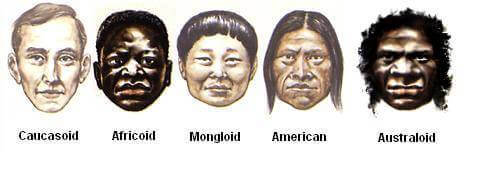CAUCASOID, one of the major racial groups of mankind found in Europe, the Americas, North Africa, the Middle East, and India. “Caucasoid” or “Caucasian” is often equated with “white,” but this is inaccurate because the group includes many populations of dark conıplexion.
The term was coined by Johann Friedrich Blumenbach in the 18th century because the skull he took as typical for the group was that of the Georgian women from the Caucasus. Blumenbach thought the type may have originated in the Caucasus, but in fact no one knows.

Skin color among Caucasoids varies from pale, reddishwhite to dark brown. Head hair varies from silky straight to curly. It is almost never woolly, rarely frizzly, and the individual hairs are seldom as coarse or as sparsely distributed as in Mongoloids. In males, the hair on the face and over the rest of the body is usually well developed. Ali forms of head shape occur, but the general tendency is to broadheadedness (brachycephaly). The nose tends to be comparatively narrow and projecting. The cheekbones are generally not prominent, and the lips tend to vary from thin to moderately developed. The face tends to be straight (orthognathic), and the forehead is comparatively high.
REPRESENTATİVE CAUCASOID POPULATIONS
- Basic Mediterranean: Best seen among the Portuguese, Spaniards, and some English and Welsh; in North Africa among the Hamiticspeaking peoples; in Arabia; and among the Berbers of Morocco.
- Atlanto-Mediterranean: Principal element in the population of North Africa; strongly represented in Iraq, Israel, parts of Arabia, and the eastern Balkans, and to some extent in Portugal, Spain, and the British Isles.
- Irano-Afghan Mediterranean: The principal element in the populations of Iran, Afghanistan, the Turkoman country, found also in parts of India, Arabia, and North Africa.
- Nordic: The characteristic type of Scandinavia, found with varying frequencies in Iceland, Frisian Islands, British Isles, Belgium, the Netherlands, and the north central European plain, which is bounded by Russia on the east, and Poland and Northern Germany on the west.
- Alpine: The populations concentrated along a mountainous range extending from France along the Alps, through the Balkans and into the mountains of Asia Minor, and northwest into Russia and Siberia. The type is found sporadically throughout Europe.
- Dinaric: Sometimes called Adriatic or Illyrian. The type is found from eastern Switzerland through the Austrian Tyrol, Serbia, Montenegro and Albania.
- Armenoid: Found in Asia Minor to the east and southeast of the Black Sea.
- Hamitic: Essentially Basic Mediterraneans, ranging over the greater part of North and East Africa. They comprise the Northern Hamites; the Libyans, or Mediterranean Berbers of Cyrenaica, Tripolitania, Tunisia, and Algeria; the Atlantic Berbers of Morocco such as the Kabyles; the West Saharan Berbers, or Tuaregs; the Tibu of East Sahara; the Fula or Fulani of Nigeria; and the extinct Guanche of the Canary Islands. The Eastern Hamites comprise the ancient and modern Egyptians, now much mixed with Arabic elements, and the Nubians, Beja, Galla, Somali, Danakil, and most Ethiopians.
- East Baltic: A type found in Germany, Poland, the Baltic States, and Finland.
- Lapps: A type found in Northern Scandinavia, in the highlands of Sweden, the tundra of northern Finland, the Norwegian coastal provinces of Troms and Finmark, and a great part of the Russian Kola Peninsula.
- Indo-Dravidians: Distributed widely throughout India and Ceylon.
- Polynesian: Pacific populations living within an area bounded by Hawaii in the North, the Fiji Islands in the Southwest, and to New Zealand and Easter Island in the East.